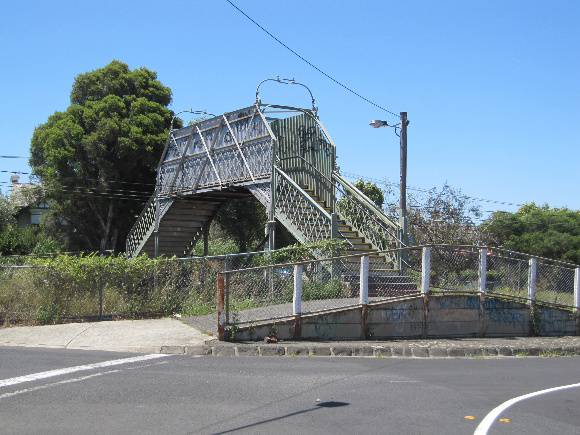| Back to search results » | Back to search page » |
|
RAILWAY FOOTBRIDGE (EGLINTON STREET)
Other NameReview LocationEGLINTON STREET, EDGAR STREET, and MOORE STREET, MOONEE PONDS, MOONEE VALLEY CITY LevelIncluded in Heritage Overlay |
|
Statement of Significance
What is significant? Non-original alterations and additions to the footbridge, which include the bluestone blocks at base of the steps, asphalt surfacing of the deck, metal plates to create risers between each tread, ramps, tubular steel handrails and corrugated galvanised steel sheeting to the balustrades are not significant. How is it significant? Why is it significant? The footbridge is architecturally significant as the most complete example of a distinctive arched footbridge on the Essendon line. It has aesthetic significance as a finely ornamented structure, which contributes to the historic nineteenth century character of the railway and its environs (Criteria D & E).
The Eglinton Street railway footbridge, constructed in 1890 by D. Watson, builder of most of the footbridges on the Essendon line, is significant. The bridge is built predominantly of iron, (frame, balustrading, brackets), with some timber (treads and deck). On the web of some iron is marked the Darlington Iron Company Limited. Another mark on the web that has 'VR', indicates the iron was specifically produced for the Commissioners of the Victorian Railways. The deck of the footbridge spans two tracks and has a lattice balustrade. Higher diagonal iron elements extend above the balustrade, and these support lamp brackets at each end of the deck (lamps removed). The steps extend to the east and west of the deck, and from a landing return to the north (west side of railway line) and to the south (east side of railway line). The balustrades of the steps are also lattice, of a design that is consistent with that of the deck. Further enhancing the character of the bridge are iron brackets with scroll detailing and a capital-like element towards the tops of the iron columns. A remnant of a base with a similar profile to the capital is evident on the iron column at the north east.
The Eglinton Street railway footbridge is of local historic, architectural and social significance to the City of Moonee Valley.
The footbridge is historically significant as evidence of the development of the suburban railway network in Moonee Valley and also associated growth in population that created a need for safe crossing places along the railway between stations. The footbridge is historically and socially significant as a manifestation of the land boom era in Essendon and the associated social prospects and its community use over a long period. In its ornamental form, the footbridge is a reminder of the important role of the railways in transport around the 19th century metropolis and shows a significant association with the social expectations and ways of the period (Criteria A & G).
Group
Transport - Rail
Category
Foot Bridge




